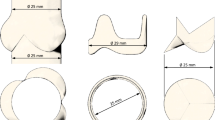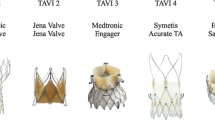Abstract
The effective orifice area (EOA) is the most commonly used parameter to assess the severity of aortic valve stenosis as well as the performance of valve substitutes. Particle image velocimetry (PIV) may be used for in vitro estimation of valve EOA. In the present study, we propose a new and simple method based on Howe’s developments of Lighthill’s aero-acoustic theory. This method is based on an acoustical source term (AST) to estimate the EOA from the transvalvular flow velocity measurements obtained by PIV. The EOAs measured by the AST method downstream of three sharp-edged orifices were in excellent agreement with the EOAs predicted from the potential flow theory used as the reference method in this study. Moreover, the AST method was more accurate than other conventional PIV methods based on streamlines, inflexion point or vorticity to predict the theoretical EOAs. The superiority of the AST method is likely due to the nonlinear form of the AST. There was also an excellent agreement between the EOAs measured by the AST method downstream of the three sharp-edged orifices as well as downstream of a bioprosthetic valve with those obtained by the conventional clinical method based on Doppler-echocardiographic measurements of transvalvular velocity. The results of this study suggest that this new simple PIV method provides an accurate estimation of the aortic valve flow EOA. This new method may thus be used as a reference method to estimate the EOA in experimental investigation of the performance of valve substitutes and to validate Doppler-echocardiographic measurements under various physiologic and pathologic flow conditions.






Similar content being viewed by others
References
Abdallah SA, Hwang NHC (1987) Arterial stenosis murmurs: an analysis of flow and pressure fields. J Acoust Soc Am 83(1):318–334
Anthoine J, Mettenleiter M, Repellin O, Buchlin JM, Candel S (2003) Influence of adaptative control on vortex-driven instabilities in a scaled model of solid propellant motors. J Sound Vib 262:1009–1046
Arsenault M, Masani N, Magni G, Yao J, Deras L, Pandian N (1998) Variation of anatomic valve area during ejection in patients with valvular aortic stenosis evaluated by two-dimensional echocardiographic planimetry: comparison with traditional Doppler data. J Am Coll Cardiol 32(7):1931–1937
Balducci A, Grigioni M, Querzoli G, Romano GP, Daniele C, Avenio GD, Barbaro V (2004) Investigation of the flow field downstream of an artificial heart valve by means of PIV and PTV. Exp Fluids 34:204–213
Batchelor GK (1967) Introduction to fluid dynamics. Cambridge University Press, Cambridge
Beauchesne LM, deKemp R, Chan KL, Burwash IG (2003) Temporal variations in effective orifice area during ejection in patients with valvular aortic stenosis. J Am Soc Echocardiogr 16(9):958–964
Bermejo J, Antoranz JC, Garcia-Fernandez MA, Moreno MM, Delcan JL (2000) Flow dynamics of stenotic aortic valves assessed by signal processing of Doppler spectrograms. Am J Cardiol 85(5):611–617
Borisyuk AO (2002) Experimental study of noise produced by steady flow through a simulated vascular stenosis. J Sound Vib 256(3):475–498
Braunwald E, Zipes DP, Libby P (2001) Heart disease, 6th edn. W.B. Saunders Company, Philadelphia, London, New York, Saint Louis, Sydney, Toronto, pp 1643–1713
Brucker CH, Steinseifer U, Schroder W, Reul H (2002) Unsteady flow through a new mechanical heart valve prosthesis analysed by digital particle image velocimetry. Meas Sci Technol 13(7):1043–1049
Clark C (1976) The fluid mechanics of aortic stenosis II: unsteady flow experiments. J Biomechanics 9:567–573
DeGroff CG, Shandas R, Valdes-Cruz L (1998) Analysis of the effect of flow rate on the Doppler continuity equation for stenotic orifices area calculations: a numerical study. Circulation 97:1597–1605
Garcia D, Pibarot P, Landry C, Allard A, Chayer B, Dumesnil JG, Durand LG (2004) Estimation of aortic valve effective orifice area by Doppler echocardiography: effects of valve inflow shape and flow rate. J Am Soc Echocardiogr 17(7):756–765
Garitey V, Gandelheid T, Fuseri J, Pelissier R, Rieu R (1995) Ventricular flow dynamic past bileaflet prosthetic heart valves. Int J Artif Organs 18(7):380–391
Grose RD (1985) Orifice contraction coefficient for invicid incompressible Flow. J Fluids Eng 107:36–43
Howe MS (2002) Theory of vortex sound. Cambridge University Press, Cambridge
Howe MS (2004) Mechanism of sound generation by low mach number flow over a wall cavity. J Sound Vib 273:103–123
Idelchik IE (2001) Handbook of hydraulic resistance, 3rd edn. Begell House, New York
Kadem L, Pibarot P, Dumesnil JG, Mouret F, Garitey V, Durand LG, Rieu R (2002) Independent contribution of left ventricular ejection time to the mean gradient in aortic stenosis. J Heart Valve Dis 11(5):615–623
Keane RD, Adrian RJ (1990) Optimization of particle image velocimeter. Part 1: double pulsed systems. Meas Sci Technol 1:1202–1215
Kim HB, Hertzberg JR, Shandas R (2004) Development and validation of echo PIV. Exp Fluids 36:455–462
Knapp Y, Bertrand E (2005) Particle imaging velocimetry measurements in a heart simulator. J Visual (in press)
Landau LD, Lifshitz EM (1987) Fluid mechanics, 2nd edn. Oxford Pergamon Press, New York
Lim WL, Chew YT, Chew TC, Low HT (2001) Pulsatile flow studies of a porcine bioprosthetic valve in vitro: PIV measurements and shear-induced blood damage. J Biomech 34(11):1417–1427
Marassi M, Castellini P, Pinotti M, Scalie L (2004) Cardiac valve prosthesis flow performances measured by 2D and 3D-stereo particle image velocimetry. Exp Fluids 36:176–186
Mascherbauer J, Huber L, Schima H, Baumgartner H (1999) Flow dependence of aortic valve areas as calculated by the Doppler continuity equation does not reflect actual changes of the effective orifice area. Circulation 100(I):1-653
Milne-Thompson LM (1996) Theoretical hydrodynamics, 5th edn. Dover Publications, New York
Miyauchi T, Tanahashi M, Li Y (2001) Sound generation in chemically reacting mixing layers. Smart control of turbulent combustion. Springer, Berlin Heidelberg New York, pp 28–38
Nichols WW, O’Rourke MF (1998) McDonald’s blood flow in arteries: theoretical, experimental and clinical principles, 4th edn. Arnold, London
Powell A (1964) Theory of vortex sound. J Acoust Soc Am 36(1):177–195
Raffel M, Willert C, Kompenhans J (1998) Particle image velocimetry. Springer, Berlin Heidelberg New York
Shandas R (1996) In vitro measurement of the vena contracta for stenotic valves using laser induced fluorescence imaging and digital particle image velocimetry: comparison with ultrasound Doppler. In: Proceedings of the 18th annual international conference of the IEEE engineering in medicine and biology
Shandas R, Kwon J, Valdes-Cruz L (2000) A method for determining the reference effective flow areas for mechanical heart valve prostheses: in vitro validation studies. Circulation 101:1953–1959
Stitou A, Riethmuller ML (2001) Extension of PIV to super resolution using PTV. Meas Sci Technol 12:1398–1403
Tkachuk AY (1993) Application of the method of singularities for evaluation of the turbulent jet-type boundary-layer flow. Heat Transfer Res 25:102–108
Trujillo NP, Kwon J, Kringlen M, Shandas R (1996) Comparaison of effective orifice area calculations using the continuity equation in steady and pulsatile flow. J Am Coll Cardiol 27(2 Suppl I):233
Voelker W, Reul H, Nienhaus G, Stelzer T, Schmitz B, Steegers A, Karsch KR (1995) Comparaison of valvular resistance, stroke work loss, and Gorlin valve area for quantification of aortic stenosis: an in vitro study in a pulsatile aortic flow model. Circulation 91:1196–1204
Zamir M (2000) The physics of pulsatile flow. Springer, Berlin Heidelberg New York (biological physics series)
Acknowledgments
The authors thank Claudia Jones, Martine Lauzier and Mickael Savinaud for their technical assistance. This work was supported by a grant of the Canadian Institutes of Health Research (MOP-10929), Ottawa, Ontario, Canada. Dr. Pibarot is the director of the Canada Research Chair in Valvular Heart Diseases, Canadian Institutes of Health Research, Ottawa, Ontario, Canada.
Author information
Authors and Affiliations
Corresponding author
Rights and permissions
About this article
Cite this article
Kadem, L., Knapp, Y., Pibarot, P. et al. A new experimental method for the determination of the effective orifice area based on the acoustical source term. Exp Fluids 39, 1051–1060 (2005). https://doi.org/10.1007/s00348-005-0038-0
Received:
Revised:
Accepted:
Published:
Issue Date:
DOI: https://doi.org/10.1007/s00348-005-0038-0




